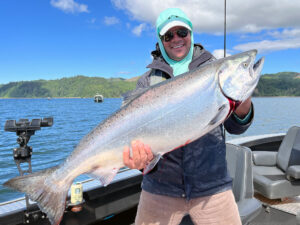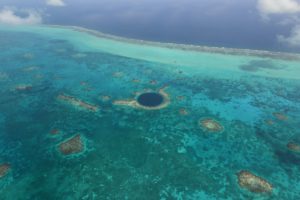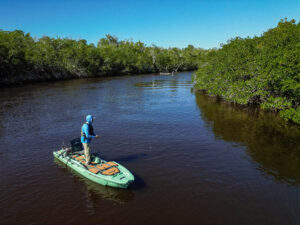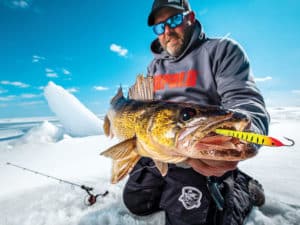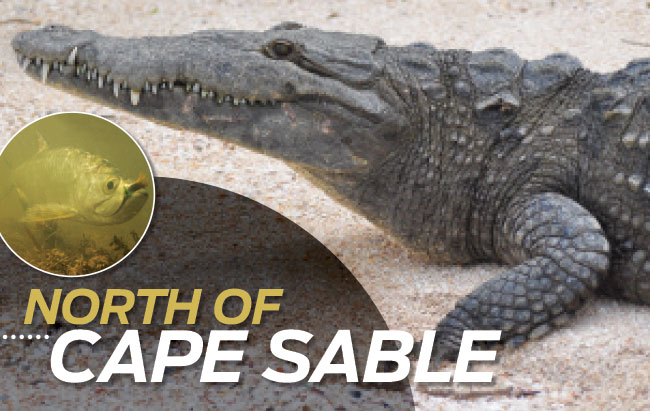
cape sable gator
The big Yamaha outboard pushed Capt. Jim Wilcox’s classic 1988 18-foot Action Craft bay boat farther and farther into the mangrove jungle. We were nearing the end of a mesmerizing journey, now following ever-narrowing channels through the densest mangroves.
At times, Wilcox had to stop in the most overgrown creeks, and we forced the boat through with a combination of poling and pulling. Our efforts were rewarded when we eventually emerged into a tranquil, hidden lagoon.
The waters were clear back here and lit by the sun shining down from a cloudless sky — conditions perfect for sight-fishing. We spotted the humped bow waves of cruising reds pushing across a flat and occasionally the seductive sight of a waving tail. And we soon discovered that almost any well‑placed cast would result in a solid hookup.
It seemed wonderfully obvious that many areas like this, fished very little indeed, awaited us.
Milky Florida Bay
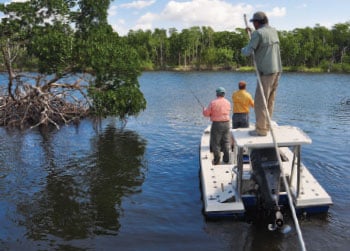
|
Rewind to earlier that day, as I sat in the predawn blackness savoring my morning coffee, listening to the wind rattling through the outrigger halyards of the sport-fishing fleet lining the dock at Bud N’ Mary’s Marina in Islamorada. Sure, we would be going fishing, just as we had the previous three days, but once again our options would be severely limited; those strong April winds had roiled the shallows and channels of Florida Bay to the consistency of milk.
Soon, a truck pulled up outside. Wilcox strolled into the marina’s deli, poured himself a coffee and sat down across from me. Wilcox is one of many stellar backcountry guides who berth their bay boats and skiffs at Bud N’ Mary’s.
As he took a thoughtful slug from the steaming mug, Wilcox said: “Dave, you interested in trying something different today? How about a day fishing for reds and snook — in clear water? I’ve been discussing our options with Bill Bassett” — our group’s other backcountry guide — “and we want to try an area up in the Everglades, north of Cape Sable. It’ll be a long run, but I was there last week, and the fishing was awesome!”
Reaching Out
I knew that, traditionally, most of these guides have concentrated on fishing relatively close to home, often casting their first lines less than 10 minutes after leaving the dock.
So I asked Ricky Stanczyk, son of Bud N’ Mary’s owner Capt. Richard Stanczyk, if he had noticed a change in fishing patterns in recent years. The younger Stanczyk also runs a backcountry boat out of the marina.
“Yes, backcountry fishing today, especially here in Islamorada, has changed dramatically from what it was 15 years ago,” he said. “Several factors come into play with these trends, one being the evolution of boats and engines. Guides are using larger boats — bay boats and big skiffs — capable of taking larger groups of people and in a lot more comfort, especially across open Florida Bay and the Gulf of Mexico. Also, four-stroke outboards are very good on fuel, so you can travel much-farther distances more economically.
“Back when my dad first started out, the bonefishing was so good around Islamorada that not many guides fished back in the [Everglades National] Park much. Then, a 20-mile run to Flamingo was considered a long haul. Nowadays, we often run 30 to 40 miles back [into the Everglades],” Stanczyk said.
“I think fishermen themselves have changed a good deal too,” he added. “We see many more novices, and families and friends, who want to catch a variety of fish and have a good time, and aren’t necessarily adamant about catching that dream 15-pound bonefish on fly. Of course, there are still anglers out there who want to catch that one huge trophy bonefish, and there are guides specializing in trophy fishing for bones as well as permit.”
Exhilarating Ride
Wilcox is one of those Islamorada guides who doesn’t hesitate to run long distances with his anglers. “Sure, we still fish tarpon around Islamorada in season, and other species too, but these days we regularly run out as far as Sandy Key to fish for both tarpon and sharks, or farther north to Snake Bite, south of Flamingo, for reds and snook, or way out into the Gulf to fish the wrecks for grouper and permit,” Wilcox said. “Depending upon conditions, we sometimes — increasingly — run even farther, beyond Cape Sable.”
I didn’t have to think twice about Wilcox’s suggestion that breezy morning, and soon our two boats slipped quietly out of Bud N’ Mary’s and under the low U.S. Route 1 bridge just as the sun started to lighten the horizon out behind us, beyond Alligator Light. Using the numerous shallow banks to provide as much of a lee as possible from the strong winds, we made surprisingly swift progress north to the Cape Canal, then continued through Whitewater Bay and on up into Ponce De Leon Bay. The journey was an exhilarating one. When it comes to blowing away the morning cobwebs, there’s nothing quite like a high-speed ride aboard an open boat; if anything, a long ride to fish a new area only helps build the excitement and anticipation of the day ahead.
From there, we emerged into the open Gulf, then ran even farther north to enter Everglades National Park through a narrow creek mouth that had been invisible until we were all but upon it.
Rise of the Reds
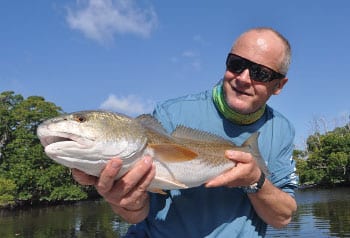
| |The author fishes the world, but says he’d be hard-pressed to find a better fishery than shallow-water reds offer.|
But anglers now report that snook are clearly on the rebound after the devastating fish kill in the cold snap of January 2010. Also, since the freeze, redfish numbers have really surged.
“There are a few things we think have helped the redfish population,” Stanczyk said. “One is a healthy respect among anglers for the species — especially here in Islamorada, where we treat them as game fish, and rarely as table fare. Redfish were one of the game-fish species during the freeze of 2010 able to survive in the 50-degree water.
“After that, without numbers of snook and tarpon, they had these waters mostly to themselves and were likely able to populate undisturbed by predation for a while.
“Also, years ago, many redfish were raised in hatcheries and released in various areas of the state. We’re also likely seeing the effects from this now. Finally, there has been some good work done by the Park Service to protect areas of the flats and vital habitat in the backcountry, establishing no-motor zones, idle-wake zones and so on.”
Fast Action
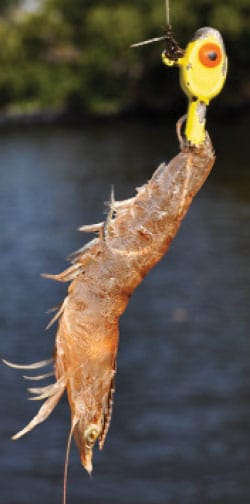
| |While one might fish fancier, in these waters the basic jig-head-and-shrimp catches just about everything.|
From the open Gulf, the creek snaked its way inland, winding incessantly through the dense tangle of mangroves. Dark, tannin-stained water flowed around bends with deep, seductive-looking dark holes. Schools of bait dimpled the surface, and an occasional boil and splash on the surface offered evidence enough of predatory game fish at work.
At a bend where a narrow secondary creek entered the main channel, Wilcox tied the bow painter line to an overhanging mangrove and handed me a rod.
We caught trout, ladyfish and an occasional mangrove snapper on our first few casts, and we soon hooked up to the first reds of the day, beautiful fish that had acquired a rich patina of burnished copper courtesy of their lives spent in tannin-rich waters.
“Flick a shrimp as far as you can up into that narrow channel, right up under that fallen tree on the right,” Wilcox said. I somehow managed to land the shrimp in the right spot. I twitched the rod tip, and the water boiled as a good fish inhaled the jig. The profusion of snags ensured that it wouldn’t be a pretty fight, but I managed to keep fish and line out of harm’s way, and soon, a seven-pound redfish shimmered in the rich, early-morning sunlight by the boat.
Remote Lagoons
Shortly after that, we entered a blind channel that ended in a tangle of sun-bleached dead trees. “Hurricane damage,” Wilcox said, “and a great place to put those ‘trophy shrimp’ to use!”
We stopped about 50 yards away from the structure, and Wilcox rerigged one of the rods with a float. “Always a few big reds hanging around here, but you’ll never manage to get a jig in there, and if you do you’ll get snagged for sure,” he said, handing me the rod. “Just cast it as close to the tree as you can. Hopefully, a big shrimp kicking about beneath the float will tempt one of those reds out into open water.”
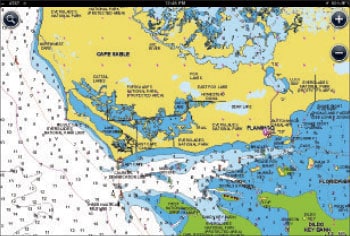
| |This Navionics chart screen shot shows the area to be a true, unspoiled wilderness.|
The cast wasn’t great, the bobber landing about six feet short, and I was about to reel in for another try when suddenly the line moved away to the right. When it tightened, I struck and came tight onto a red — a solid, multispotted 8-pounder.
We moved on to push even deeper into the tangle of mangroves, determined to access one particular lagoon Wilcox had spotted on the Google Earth website. Finally we found it, one of the sweetest-looking mangrove lagoons I have ever fished. The making tide was just starting to cover the mud flats and oyster bars as Wilcox poled us in.
While fishing the park’s waters on the first day, we had stuck to jig/shrimp combos with spinning gear; during subsequent days, I put my fly rod to good use. I soon discovered that a well-placed Clouser was the perfect choice for reds, snook and several other species.
Fish were moving everywhere, and soon we were again racking up the sort of release numbers that produces looks of doubt when retold later during happy hour. It had been a long run to get up here, and worth every minute of it.
Fact File: planning a fishing trip North of Cape Sable
Capt. Jim Wilcox’s favorite months to fish the Everglades north of Cape Sable are October through May.
“As the water cools in fall, the big reds, snook and trout move into those creeks to over-winter, seeking thick shoals of bait and deeper pockets of water that have a more consistent temperature,” he said. “During the hotter months, many fish leave, but tarpon fishing is good.
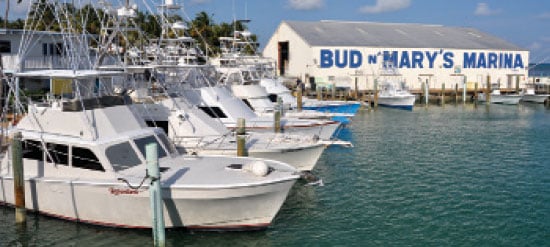
“Fishing in such tight cover such as these overgrown creeks demands a fairly short rod. I use a 6½-foot Ugly Stick matched with a light Penn spinning reel and 15-pound Power Pro braid. These versatile outfits can handle any snook, red, bone or permit but are strong enough to catch a 50-pound tarpon in a reasonable amount of time.”
Wilcox likes lead-head jigs but says they needn’t be fancy: “You’ll lose plenty,” he said. He does recommend jigs with a wide-gape hook weighing ³⁄8 to 5⁄8 ounces for varying depths and current flow.
In addition to redfish and snook, we caught speckled trout, ladyfish, snapper, sheepshead, black drum, lookdown, juvenile goliath grouper and small permit.
Most guides carry a lot of shrimp, but Wilcox and Bassett also use Berkley Gulp! Alive.
Bugs can be a problem, particularly during warmer months. Long-sleeved shirts, long pants and copious applications of bug spray help.
Bud N’ Mary’s Marina is the home for many of the best backcountry guides working the middle Keys.
“Islamorada is the perfect place to catch a multitude of fish because of easy access to the Gulf of Mexico, Florida Bay, Everglades National Park, the coral reef and, of course, the deep Atlantic,” Capt. Rick Stanczyk said. “Many of these fisheries are a farther run than what many are used to, but it often pays off, as there is far less pressure on many of these fisheries.”
The marina has a great tackle shop, a deli/cafe and a range of accommodations. For more information, visit budnmarys.com.
Current regulations for South Florida allow a daily bag limit of one redfish between 18 and 27 inches per angler. For a full listing of all regulations, visit the Florida Fish and Wildlife Conservation Commission website at: myfwc.com.
Contact Capt. Jim Wilcox via e-mail (captjim@ultimatekeysfishing.com) or cell phone (305-393-1128). Wilcox also is involved in a sawfish-conservation project; for more information, visit vimeo.com/presslaunch/savethesawfish. You can reach Capt. Bill Bassett at 305-522-4762.
About the Author: Dave Lewis (david.lewis21@btconnect.com) is a U.K.-based angling photojournalist and Shimano pro staffer. He also is a destination consultant for Anglers World Holidays, and a regular contributor to Sport Fishing. Lewis guides groups of anglers to numerous destinations around the world, including Bud N’ Mary’s.

